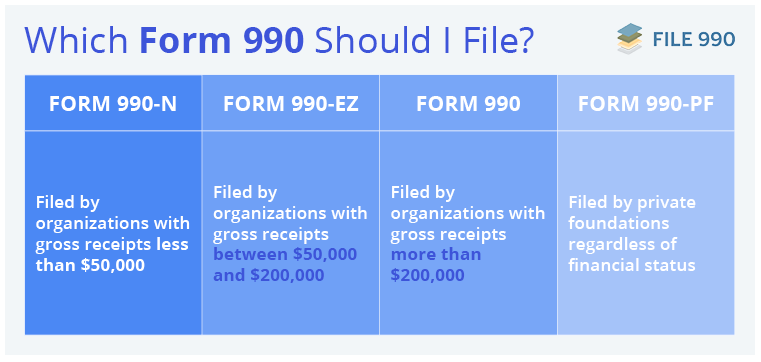From Data Collection to Filing: How to Prep Nonprofit Taxes
As a nonprofit professional, you likely wear many hats to keep the organization moving forward, from fundraiser to volunteer coordinator to budget manager. When tax season rolls around each year, you might find yourself scrambling to find the right documents and reallocating resources to afford an accountant.
However, you can avoid a frenzied race to the finish in the weeks leading up to your IRS filing deadline by implementing these simple best practices in advance:
Understand Your Nonprofit’s Tax Requirements
Collect Data
Create a Filing Plan
Select an E-Filing Software
As we go through these tips, consider how your nonprofit currently handles tax season and what internal adjustments you’d need to make to implement this structure. Let’s explore how to make your tax filing season a breeze.
1. Understand Your Nonprofit’s Tax Requirements
Whether you’re a nonprofit newbie or a seasoned professional, tax requirements for your nonprofit can be complex. Plus, nonprofits have different requirements based on their size, gross receipts, and location, which can make filing even more confusing.
That’s why you should clarify your nonprofit’s tax filing requirements from the get-go. Here are some questions you should answer:
When is our filing deadline? Your deadline is the 15th day of the fifth month after the end of your fiscal year. Most nonprofits’ fiscal years end on July 31st, making the deadline December 15th.
Do we have state-specific obligations? While the IRS manages most nonprofit tax forms, there are state-specific requirements that you should account for as well.
Are we eligible for any exemptions? Certain nonprofits can leverage extra exemptions beyond the federal income tax exemption offered to all nonprofits, such as property tax, sales tax, and postal tax exemptions.
Which extra schedules do we need to fill out? Nonprofits (especially large ones) often need to fill out additional tax forms, also known as schedules, to report additional revenue or activities.
Which type of Form 990 do we need to fill out? All nonprofits need to fill out a version of the standard Form 990 to maintain their tax-exempt status. However, each nonprofit’s required form depends on its gross receipts. Reference this table from File 990 to determine which is right for your organization:
2. Collect Data
Data collection and management, while crucial, can cause some nonprofits trouble when it’s time to file taxes. The government requires many types of data, such as revenue, expenditures, income, and budgets. After all, Form 990 is meant to increase financial transparency for nonprofits, so the form should cover all of your bases.
Fortunately, with a few adjustments to your nonprofit’s year-round data hygiene habits, you can easily maintain and reference key information during tax season. We suggest that you:
Regularly audit your financial data. Your organization, regardless of its size, collects a lot of data. Auditing your financial information is crucial for identifying and finding missing information. Even outside of tax season, this process helps you gauge your nonprofit’s financial health, an important metric for sustainable growth.
Save information in a secure online location. Whether it’s cloud-based accounting software, your constituent relationship management (CRM) software, or an e-filing solution for your taxes, digitize your paper records into an online database so you can easily reference necessary information.
Proactively update and reconcile bank accounts. As arguably the most important financial resource for your nonprofit, it’s critical that your bank accounts are regularly updated and synced with your internal financial records. This step can help you catch any discrepancies before they cause issues come tax season.
As you evaluate your current data collection and management practices, keep in mind that financial transparency is key to building donor trust. Form 990s are publicly available for donors to access, so by prioritizing data management, you display a commitment to your supporters and beneficiaries.
3. Create a Filing Plan
Standardizing your data management strategies is only the beginning of setting the stage for a smooth tax season. As your filing date approaches, ensure that you have a comprehensive plan in place to achieve everything you need before the deadline. Your nonprofit’s filing plan should include:
Your timeline
A checklist of required documents
Roles and responsibilities
How you’ll file and submit your tax forms
As you write your plan, remember that the IRS has mandated that all nonprofits submit their taxes via certified e-filing software. That said, by using e-filing software for your nonprofit’s taxes, you can ensure data accuracy, automate reminders so you don’t miss important deadlines, and easily carry over your information into future tax seasons. Plus, using e-filing software is ideal for nonprofits with smaller budgets (like those that file a 990-N postcard) who aren’t able to hire an accountant.
Bonus Step: File, Review, and Plan for Next Year
Once you’ve put the finishing touches on your filing plan, it’s time to send off your tax forms and follow data maintenance best practices. As part of your planning for next year, consistently review your data, fill in any gaps, and leverage powerful e-filing software so you can ensure smooth tax seasons for years to come.
Want to learn more about proper data management to improve your tax filing and other internal processes? Sign up for our “Data You Can Use”.


